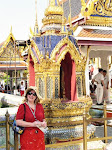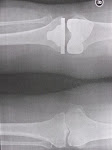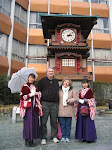This red camellia was my first project. Our Sensei (teacher) is very patient, and very good at starting us out with easier projects in the beginning, and then progressively giving us more difficult projects as our skills improve. Color shading is accomplished by layering very thin paper. The leaf veins are made from stretching & rolling (with a little glue) very small pieces of this beautiful hand made paper.


Our Sensei designs our pictures & then has someone make up the kits for us, consisting of a board, and usually double the amount of paper we will need. We have an instruction sheet, but it's all in Japanese, so we have to get it translated as we go along. We trace the picture design onto the board with charco paper (very similar to carbon paper).
These cherries hang on my kitchen wall above the phone. It's amazing how the shading make them appear round, plump & shiny!


You may have noticed the stamp & Japanese characters at the bottom of the pictures. When I joined the class, we had long discussions about my name, and it was the consensus of the group that I would take a Japanese name. Mostly, because American names typically do not translate well, and the characters don't look very pretty if they do. So, we spent several tea times (a break during our class for tea & snacks) discussing my preferences. When I said, "Fish" they thought this was very funny. So, then I said, "the sea" and that went over better. My name became Nagisa, which means "soft wave." I think it suits me. Sensei writes my Japanese name in calligraphy & then stamps it in Kanji (old Chinese script made up of a picture). Some Kanji characters tell a whole story!
This poppy hangs in the living room. It is very delicate. Chigerie looks much like watercolor when compete.


I love the delicate nature of this starflower. Don't know if you can see, but the stems are segmented, much like bamboo.

I love the colors in this pansy picture. The vase has many, many layers to get this effect. Each project takes weeks & weeks to complete, so we say they are "very valuable" when finished!

This morning glory is one of my favorites. Framed in a Japanese round frame, it hangs in my bedroom. Notice how the delicate vine runs off the board & then comes back on. I love the way Japanese art is "centered" in a very different way.


White cosmos -- the last project I finished before I left for the summer. It is the first one to be made onto a dark board. Seisei stamped & calligraphied (is that a word?) my Japanese name in gold. Fancy, huh?


I'm currently working on a picture of a little white mouse & a dark red beet, and will try to remember to show you when I'm finished. We are doing this, because the Year of the Rat is coming soon. We are closing out the Year of the Wild Boar. Although Japan used to celebrate the New Year in early February (along with most of the rest of Asia), it is now celebrated on 1/1.
When you reach the bottom of a page, click "Older Posts" to continue . . .






















No comments:
Post a Comment